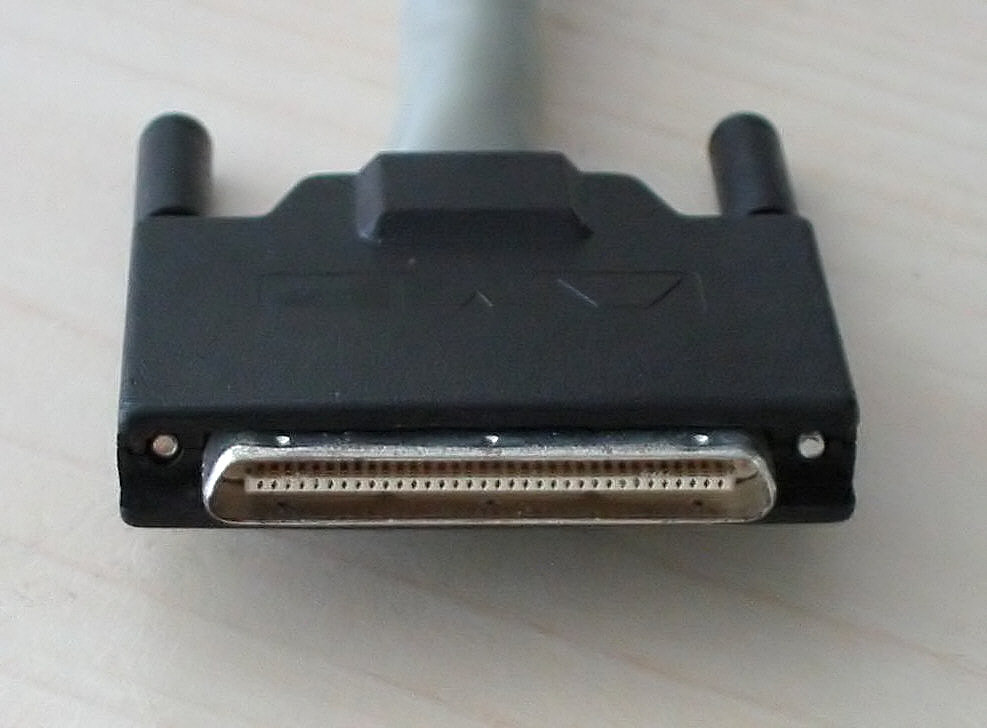|
VHDCI
A very-high-density cable interconnect (VHDCI) is a 68-pin connector that was introduced in the SPI-2 document of SCSI-3. The VHDCI connector is a very small connector that allows placement of four wide SCSI connectors on the back of a single PCI card slot. Physically, it looks like a miniature Centronics type connector. It uses the regular 68-contact pin assignment. The male connector (plug) is used on the cable and the female connector ("receptacle") on the device. Other uses Apart from the standardized use with the SCSI interface, several vendors have also used VHDCI connectors for other types of interfaces: * Nvidia: for an external PCI Express 8-lane interconnect, and used in Quadro Plex VCS and in Quadro NVS 420 as display port connector* ATI Technologies: on the FireMV 2400 to convey two DVI and two VGA signals on a single connector, and ganging two of these connectors side by side in order to allow the FireMV 2400 to be a low-profile quad display card. The Radeon X19 ... [...More Info...] [...Related Items...] OR: [Wikipedia] [Google] [Baidu] |
Eyefinity
AMD Eyefinity is a brand name for AMD video card products that support multi-monitor setups by integrating multiple (up to six) display controllers on one GPU. AMD Eyefinity was introduced with the Radeon HD 5000 Series "Evergreen" in September 2009 and has been available on APUs and professional-grade graphics cards branded AMD FirePro as well. AMD Eyefinity supports a maximum of 2 non-DisplayPort displays (e.g., HDMI, DVI, VGA, DMS-59, VHDCI) (which AMD calls "legacy output") and up to 6 DisplayPort displays simultaneously using a single graphics card or APU. To feed more than two displays, the additional panels must have native DisplayPort support. Alternatively active DisplayPort-to-DVI/HDMI/VGA adapters can be employed. The setup of large video walls by connecting multiple computers over Gigabit Ethernet or Ethernet is also supported. The version of AMD Eyefinity (aka DCE, display controller engine) introduced with Excavator-based Carrizo APUs features a Video underlay pi ... [...More Info...] [...Related Items...] OR: [Wikipedia] [Google] [Baidu] |
FireMV
AMD FireMV, formerly ATI FireMV, is brand name for graphics cards marketed as a Multi-Display 2D video card, with 3D capabilities same as the low-end Radeon graphics products. It competes directly with Matrox professional video cards. FireMV cards aims at the corporate environment who require several displays attached to a single computer. FireMV cards has options of dual GPU, a total of four display output via a VHDCI connector, or single GPU, a total of two display output via a DMS-59 connector. FireMV cards are available for PCI and PCI Express interfaces. Although these are marketed by ATI as mainly 2D cards, the FireMV 2250 cards support OpenGL 2.0 since it is based on the RV516 GPU found in the Radeon X1000 Series released 2005. The FireMV 2260 is the first video card to carry dual DisplayPort output in the workstation 2D graphics market, sporting DirectX 10.1 support. [...More Info...] [...Related Items...] OR: [Wikipedia] [Google] [Baidu] |
SCSI Connector
A SCSI connector ( ) is used to connect computer parts that use a system called SCSI to communicate with each other. Generally, two connectors, designated male and female, plug together to form a connection which allows two components, such as a computer and a disk drive, to communicate with each other. SCSI connectors can be electrical connectors or optical connectors. There have been a large variety of SCSI connectors in use at one time or another in the computer industry. Twenty-five years of evolution and three major revisions of the standards resulted in requirements for Parallel SCSI connectors that could handle an 8, 16 or 32 bit wide bus running at 5, 10 or 20 megatransfer/s, with conventional or differential signaling. Serial SCSI added another three transport types, each with one or more connector types. Manufacturers have frequently chosen connectors based on factors of size, cost, or convenience at the expense of compatibility. SCSI makes use of cables to connect dev ... [...More Info...] [...Related Items...] OR: [Wikipedia] [Google] [Baidu] |
PCI Express
PCI Express (Peripheral Component Interconnect Express), officially abbreviated as PCIe or PCI-e, is a high-speed serial computer expansion bus standard, designed to replace the older PCI, PCI-X and AGP bus standards. It is the common motherboard interface for personal computers' graphics cards, hard disk drive host adapters, SSDs, Wi-Fi and Ethernet hardware connections. PCIe has numerous improvements over the older standards, including higher maximum system bus throughput, lower I/O pin count and smaller physical footprint, better performance scaling for bus devices, a more detailed error detection and reporting mechanism (Advanced Error Reporting, AER), and native hot-swap functionality. More recent revisions of the PCIe standard provide hardware support for I/O virtualization. The PCI Express electrical interface is measured by the number of simultaneous lanes. (A lane is a single send/receive line of data. The analogy is a highway with traffic in both directions. ... [...More Info...] [...Related Items...] OR: [Wikipedia] [Google] [Baidu] |
Nvidia Quadro Plex
The Nvidia Quadro Plex is an external graphics processing unit ''(Visual Computing System)'' designed for large-scale 3D visualizations. The system consists of a box containing a pair of high-end Nvidia Quadro graphics cards featuring a variety of external video connectors. A special PCI Express card is installed in the host computer, and the two are connected by VHDCI cables. Specifications The Nvidia Quadro Plex system supports up to four GPUs per unit. It connects to the host PC via a small form factor PCI Express card connected to the host, and a Nvidia Quadro Plex Interconnect Cable. The system is housed in an external case that is approximately 9.49 inches in height, 5.94 inches in width, and 20.55 inches in depth and weighs about 19 pounds. The system relies heavily on Nvidia's SLI technology. Targeted audiences The Plex is aimed at large CGI animation companies, such as Pixar and DreamWorks Animation. This product is one of several professional graphics sol ... [...More Info...] [...Related Items...] OR: [Wikipedia] [Google] [Baidu] |
Nvidia Quadro
Quadro was Nvidia's brand for graphics cards intended for use in workstations running professional computer-aided design (CAD), computer-generated imagery (CGI), digital content creation (DCC) applications, scientific calculations and machine learning. Differences between the professional Quadro and mainstream GeForce lines include the use of ECC memory and enhanced floating point precision. These are desirable properties when the cards are used for calculations which, in contrast to graphics rendering, require reliability and precision. The Nvidia Quadro product line directly competed with AMD's Radeon Pro (formerly FirePro/FireGL) line of professional workstation cards. Nvidia has moved away from the Quadro branding for new products, starting with the launch of the Ampere architecture-based RTX A6000 on October 5, 2020. To indicate the upgrade to the Nvidia Ampere architecture for their graphics cards technology, Nvidia RTX is the product line being produced and developed m ... [...More Info...] [...Related Items...] OR: [Wikipedia] [Google] [Baidu] |
Electrical Signal Connectors
Electricity is the set of physical phenomena associated with the presence and motion of matter that has a property of electric charge. Electricity is related to magnetism, both being part of the phenomenon of electromagnetism, as described by Maxwell's equations. Various common phenomena are related to electricity, including lightning, static electricity, electric heating, electric discharges and many others. The presence of an electric charge, which can be either positive or negative, produces an electric field. The movement of electric charges is an electric current and produces a magnetic field. When a charge is placed in a location with a non-zero electric field, a force will act on it. The magnitude of this force is given by Coulomb's law. If the charge moves, the electric field would be doing work on the electric charge. Thus we can speak of electric potential at a certain point in space, which is equal to the work done by an external agent in carrying a unit of positiv ... [...More Info...] [...Related Items...] OR: [Wikipedia] [Google] [Baidu] |
General-purpose Input/output
A general-purpose input/output (GPIO) is an uncommitted digital signal pin on an integrated circuit or electronic circuit (e.g. MCUs/ MPUs ) board which may be used as an input or output, or both, and is controllable by software. GPIOs have no predefined purpose and are unused by default. If used, the purpose and behavior of a GPIO is defined and implemented by the designer of higher assembly-level circuitry: the circuit board designer in the case of integrated circuit GPIOs, or system integrator in the case of board-level GPIOs. Integrated circuit GPIOs Integrated circuit (IC) GPIOs are implemented in a variety of ways. Some ICs provide GPIOs as a primary function whereas others include GPIOs as a convenient "accessory" to some other primary function. Examples of the former include the Intel 8255, which interfaces 24 GPIOs to a parallel communication bus, and various GPIO ''expander'' ICs, which interface GPIOs to serial communication buses such as I²C and SMBus. An example o ... [...More Info...] [...Related Items...] OR: [Wikipedia] [Google] [Baidu] |
AES3
AES3 is a standard for the exchange of digital audio signals between professional audio devices. An AES3 signal can carry two channels of pulse-code-modulated digital audio over several transmission media including balanced lines, unbalanced lines, and optical fiber. AES3 was jointly developed by the Audio Engineering Society (AES) and the European Broadcasting Union (EBU) and so is also known as AES/EBU. The standard was first published in 1985 and was revised in 1992 and 2003. AES3 has been incorporated into the International Electrotechnical Commission's standard IEC 60958, and is available in a consumer-grade variant known as S/PDIF. History and development The development of standards for digital audio interconnect for both professional and domestic audio equipment, began in the late 1970s in a joint effort between the Audio Engineering Society and the European Broadcasting Union, and culminated in the publishing of AES3 in 1985. The AES3 standard has been revised in ... [...More Info...] [...Related Items...] OR: [Wikipedia] [Google] [Baidu] |
Juniper Networks
Juniper Networks, Inc. is an American multinational corporation headquartered in Sunnyvale, California. The company develops and markets networking products, including routers, switches, network management software, network security products, and software-defined networking technology. The company was founded in 1996 by Pradeep Sindhu, with Scott Kriens as the first CEO, who remained until September 2008. Kriens has been credited with much of Juniper's early market success. It received several rounds of funding from venture capitalists and telecommunications companies before going public in 1999. Juniper grew to $673 million in annual revenues by 2000. By 2001 it had a 37% share of the core routers market, challenging Cisco's once-dominant market-share. It grew to $4 billion in revenues by 2004 and $4.63 billion in 2014. Juniper appointed Kevin Johnson as CEO in 2008, Shaygan Kheradpir in 2013 and Rami Rahim in 2014. Juniper Networks originally focused on core routers, whic ... [...More Info...] [...Related Items...] OR: [Wikipedia] [Google] [Baidu] |
Balanced Audio
Balanced audio is a method of interconnecting audio equipment using balanced interfaces. This type of connection is very important in sound recording and production because it allows the use of long cables while reducing susceptibility to external noise caused by electromagnetic interference. The balanced interface guarantees that induced noise appears as common-mode voltages at the receiver which can be rejected by a differential device. Balanced connections typically use shielded twisted-pair cable and three-conductor connectors. The connectors are usually three-pin XLR or TRS phone connectors. When used in this manner, each cable carries one channel, therefore stereo audio (for example) would require two of them. Applications Many microphones operate at low voltage levels and some with high output impedance (hi-Z), which makes long microphone cables especially susceptible to electromagnetic interference. Microphone interconnections are therefore a common application for a ... [...More Info...] [...Related Items...] OR: [Wikipedia] [Google] [Baidu] |





